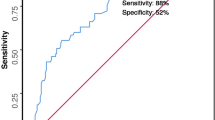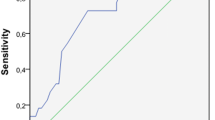Abstract
Scoring systems are mandatory to quantify the severity of abdominal sepsis on the basis of objective criteria. The Mannheim Peritonitis Index (MPI) is a disease-specific score based on easy to handle clinical parameters. APACHE II is a large-scale general scoring system with acute physiological and chronic health parameters. To evaluate the prognostic value of both systems 108 patients with severe abdominal infection managed by open treatment entered a prospective study. 32 patients (29.6%) died, 23 of them due to sepsis and 9 from other causes. Both MPI and APACHE II scores correlated closely with mortality, with three and two significantly different classes, respectively. Statistical validation showed a sensitivity of 93% and a specificity of 16% for MPI, and 89% and 25% for the APACHE 11. ROC curves were nearly parallel for both scores. In conclusion there was no significant difference in prognostic value between the scoring systems.
Zusammenfassung
Zur Beurteilung des Schweregrads und der Prognose einer Peritonitis werden objektive Scores gefordert. Der Mannheimer Peritonitis-Index ist ein krankheitsspezifischer Score, der auf einfach zu erhebenden klinischen Parametern beruht. Der APACHE 11 ist ein allgemeiner intensivmedizinischer Score, der aufwendige akute physiologische und chronische Parameter beruücksichtigt. Der Wert der beiden Systeme im Hinblick auf ihre Fähigkeit zur Risikoklassifikation und Prognosevorhersage sollte in der klinischen Anwendung gepruft werden. Hierzu werden 108 Patienten mit schwerer abdominaler Infektion und offener Abdomenbehandlung im Elahmen einer prospektiven Studie ausgewertet. 32 Patienten (29,6%) starben, davon 23 an der Sepsis, 9 aus anderer Ursache. Sowohl der MPI als auch der APACHE II zeigten eine enge Korrelation mit der Letalitat, dabei konnten jeweils 3 bzw. 2 signifikant verschiedene Punktegruppen abgegrenzt werden. Beim MP1 betrug die Sensitivitat 93%, die Spezifitat 16%, die Richtigkeit 71%, beim APACHE II entsprechend 89%, 25% und 71%. Die ROC-Kurven der Scores verliefen dementsprechend fast parallel. Zusammenfassend ergaben sich zwischen dem einfach zu erhebenden MPI und dem wesentlich aufwendigeren APACHE II keine wesentlichen Unterschiede im Hinblick auf die Fähigkeit zur Risikoklassifikation und Prognosevorhersage.
Similar content being viewed by others
Literatur
Barthlen W, Bartels H, Busch R, Siewert JR (1982) Prognosefaktoren der diffusen Peritonitis. Langenbecks Arch Chir 377:89–93
Billing A, Fröhlich D, Mialkowskyj O, Stokstad P, Schildberg FW (1992) Peritonitisbehandlung mit der Etappenlavage (EL): Prognosekriterien und Behandlungsverlauf. Langenbecks Arch Chir 377:305–311
Bohnen JM, Mustard RA, Oxolm SE, Schouten BD (1988) APACHE II score and abdominal sepsis. Arch Surg 123:225–229
Demmel N, Osterholzer G, Günther B (1993) Differenzierte Behandlungsstrategie der Peritonitis: Einzeitig geschlossen mit Drainage oder often mit programmierter Reintervention/Lavage? Zentralbl Chir 118:395–400
Demmel N, Maag K, Osterholzer G (1994) Wertigkeit klinischer Parameter zur Prognosebeurteilung der Peritonitis — Validierung des Mannheimer Peritonitis-Index. Langenbecks Arch Chir 379: 152–158
Dellinger EP, Wertz MJ, Meakins JL, Solomkin JS, Allo MD, Howard RJ, Simmons RL (1985) Surgical infection stratification system for intraabdominal infection. Arch Surg 120:21–29
Farthmann EH, Schöffel U (1990) Principles and limitations of operative management of intraabdominal infections. World J Surg 14:210–217
Fugger F, Rogy M, Herbst F, Schemper M, Schulz F (1988) Validierungsstudie zum Mannheimer Peritonitis-Index. Chirurg 59:598–601
Knaus WA, Draper EA, Wagner DP, Zimmermann JE (1985) APACHE II: A severity of disease classification system. Crit Care Med 13:818–829
Knaus WA, Drapper EA, Wagner DP, Zimmer JE (1986) An evaluation of outcome from intensiv care in major medical centers. Annals Intern Med 104:410–418
Lemkuhl P, Jeck-Thole S, Pichlmayr I (1989) A new scoring system for disease intensity in a surgical intensive care unit. World J Surg 13:252–258
Linder MM, Wacha H, Feldmann U, Wesch G, Streifensand RA, Gundlach E (1987) Der Mannheimer Peritonitis-Index. Chirurg 58:84–92
Nyström PO, Bax R, Dellinger EP, Dominioni L, Knaus WA, Meakins JL, Ohmann C, Solomkin JS, Wacha H, Wittmann DH (1990) Proposed definitions for diagnosis, severity scoring, stratification and outcome for trials on intraabdominal infection. World J Surg 13:148–158
Ohmann C, Groß-Weege W (1993) Scoring-Systeme auf der chirurgischen Intensivstation. II. Chirurg 64:21–27
Poenaru D, Christou NV (1991) Clinical outcome of seriously ill surgical patients with intraabdominal infections epends on both physiologic (APACHE II Score) and immunologic (DTH Score) alterations. Ann Surg 213:130–136
Rogy M, Fugger R, Schemper M, Goss G, Schulz F (1990) Unterschiedliche Aussagekraft von zwei verschiedenen Prognose-Scores bei Patienten mit Peritonitis. Chirurg 61:297–300
Wacha H, Ohmann C (1991) Prospective evaluation of prognostic scoring systems for peritonitis. Vortrag Arbeitsgemeinschaft Peritonitis der deutschsprachigen Surgical Infection Society Europe, Frankfurt 26. 10. 1991
Author information
Authors and Affiliations
Rights and permissions
About this article
Cite this article
Demmel, N., Muth, G., Maag, K. et al. Prognosescores bei peritonitis: Mannhehner peritonitis-index oder APACHE II ?. Langenbecks Arch Chir 379, 347–352 (1994). https://doi.org/10.1007/BF00191581
Received:
Issue Date:
DOI: https://doi.org/10.1007/BF00191581




